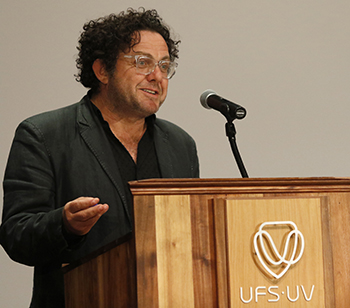
Philip Miller
Photo: Johan Roux Spotlight photo: John Hodgkiss |
Philip Miller, award-winning composer and sound artist, recently delivered the second instalment of the Vice-Chancellor’s Lecture Series on Trauma, Memory, and Representations of the Past on the Bloemfontein Campus. This lecture series forms part of a five-year research project led by Prof Pumla Gobodo-Madikizela. The series focuses on how the creative arts represent trauma and memory, and how these representations may facilitate the healing of historical wounds.
Disrupting the Silence: The Past and Transnational Memory
In Miller’s lecture, ‘Disrupting the Silence: The Past and Transnational Memory’, he discussed the creative process – and the far-researching effects – of his composition: ‘REwind: A Cantata for Voice, Tape and Testimony’. The production consists of 4 soloists, an 80- to 100-member choir, a string octet, combined with gripping projected images and audio of victims testifying during the Truth and Reconciliation (TRC) hearings.
While listening to those raw recordings, Miller would rewind continually and listen again. In between the sounds of the tape stretching and spooling, sighs, gulps for air, and moments when the speakers lost their speech, a hidden sound world revealed itself. And within these silences lay an entrenched trauma far more profound than the actual words spoken.
Communal remembering
When Miller asked Nomonde Calata how she felt about his using the recording of her heart-rending cry during her TRC testimony, her reply was poignant. For Calata, her cries – taken over by the voice of Sibongile Khumalo during the cantata – were a living memorial to her loving husband. “And it almost felt like a soothing balm to her traumatic loss,” Miller said.
“I believe that a collective body of people singing is a unique symbolic act of communal remembering. But more than that, it is a deep form of identification of our humanity, and allows for some form of catharsis for those testifiers who have attended the live performances. Just as a parent sings a lullaby to calm a crying child, the choir singing reaches those of us who continue to mourn.
“Music and song – and the arts in general – can convey the powerful stories of our nation without fearing to engage with the subject matter,” Miller said. “This I believe is the universal power of music and song: to convey a spiritual dimension to what perhaps is sometimes too graphic and painful to comprehend fully.”